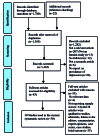Sexual and Reproductive Health Challenges in Temporary Marriage: A Systematic Review
- PMID: 34024762
- PMCID: PMC8957693
- DOI: 10.34172/jrhs.2021.42
Sexual and Reproductive Health Challenges in Temporary Marriage: A Systematic Review
Abstract
Background: Temporary marriage is a legal form of marriage in Shia Islam allowing a man and a woman to become married in a fixed period of time. This review was conducted to identify the potential effects of temporary marriage on the sexual and reproductive health of women.
Study design: A systematic review .
Methods: Electronic databases, including Web of Knowledge, Embase, PubMed, Scopus, ScienceDirect, PsycINFO, ProQuest, IranMedex, Scientific Information Database (SID), and Magiran, were searched up to October 2020 to identify the studies carried out on sexual and reproductive health challenges in temporary marriage. All the selected articles were assessed for eligibility according to their titles and abstracts.
Results: During the search on articles published within 1995 to October 2020, 1,802 relevant records were identified, and after evaluation 30 full-text papers were included in the present systematic review. Out of the 34,085 study participants in the selected studies, 3,547 subjects had temporary marriage who were studied under six different categories, namely (1) sexually transmitted infections (STIs)/human immunodeficiency viruses, (2) early child marriage, (3) unplanned pregnancy and induced abortion, (4) violence, (5) psychosocial disorders, and (6) other issues. Individuals with temporary marriage are vulnerable and need to have easy access to health education and sexual and reproductive health services in a safe and unprejudiced environment. Ignoring the aforementioned facts will cause serious public health problems, especially for women from a lower socioeconomic background.
Conclusion: In the current situation with under-reporting of temporary marriage-related events due to social stigma and absence of quality services in sexual and reproductive health, women with temporary marriage are under the additional risk of STIs, unwanted pregnancy, abortion, and violence.
Keywords: Induced Abortion; Sexually Transmitted Diseases; Temporary Marriage; Unplanned Pregnancy; Violence.
Similar articles
-
Reproductive health in adolescence.World Health Stat Q. 1994;47(1):31-5. World Health Stat Q. 1994. PMID: 8085368
-
Prevalence of Sexual Transmitted Infections (STIs) and Un-Protected Sex in Temporary Marriage in Iran: A Systematic Review and Meta-Analysis.Iran J Public Health. 2021 Jun;50(6):1156-1166. doi: 10.18502/ijph.v50i6.6414. Iran J Public Health. 2021. PMID: 34540736 Free PMC article. Review.
-
The missing link between legal age of sexual consent and age of marriage in sub-Saharan Africa: implications for sexual and reproductive health and rights.Reprod Health. 2021 Jun 21;18(1):128. doi: 10.1186/s12978-021-01177-w. Reprod Health. 2021. PMID: 34154598 Free PMC article.
-
Transition into the sexual and reproductive role: a qualitative exploration of Iranian married adolescent girls' needs and experiences.Reprod Health. 2021 Jul 27;18(1):157. doi: 10.1186/s12978-021-01208-6. Reprod Health. 2021. PMID: 34315487 Free PMC article.
-
Sexual and Reproductive Health Outcomes of Violence Against Women and Girls in Lower-Income Countries: A Review of Reviews.J Sex Res. 2021 Jan;58(1):1-20. doi: 10.1080/00224499.2019.1707466. Epub 2020 Jan 4. J Sex Res. 2021. PMID: 31902238
References
-
- Haeri S. Temporary marriage and the state in Iran: an Islamic discourse on female sexuality. Religion and Politics Journal. 1992;59(1):201–23.
-
- Tremayne S. Change and ‘face’ in modern Iran. Journal of Anthropology Middle East. 2011;1(1):25–41.
-
- Badran SZ, Turnbull B. Contemporary Temporary Marriage: A Blog-analysis of First-hand Experiences. International Women's Studies Journal. 2019;20(2):241–56.
-
- Margalit Y. Temporary Marriage: A comparison of the Jewish and Islamic Conceptions. Journal of Law & Religion. 2018;33(1):89–95.
-
- Aghajanian A, Vaezzade S, Kohan JA, Thompson V. Recent Trends of Marriage in Iran. Open Family Studies Journal. 2018;10(1):1–8.

